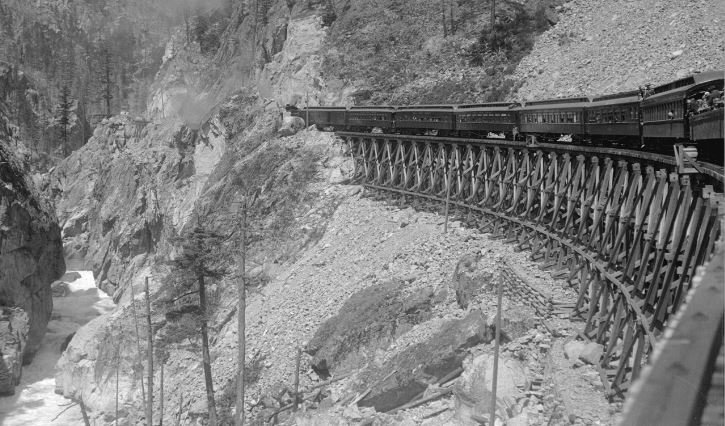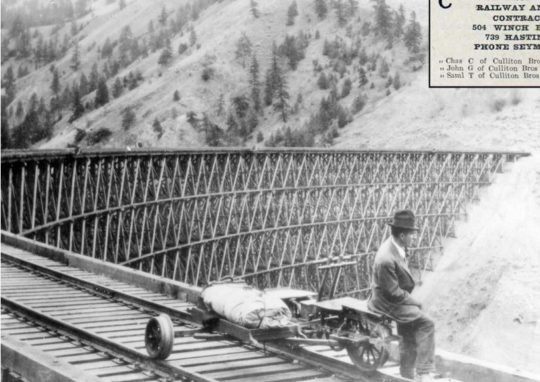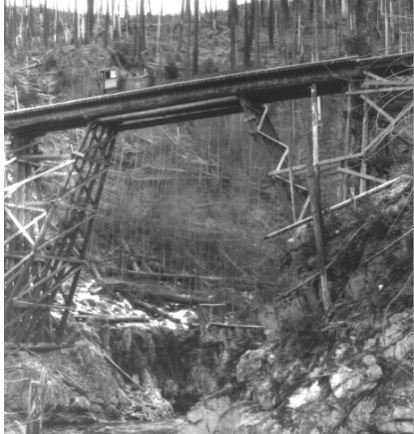
It is fortunate that Ed Aldridge often brought his camera to work, back in the late 1920s when he was working for Merrill & Ring Lumber Co.’s Squamish railway logging show.
It is also fortunate that a few historians were able to interview Ed Aldridge, in his retirement during the 1970s-80s. Much interesting information was captured for posterity.
Some of Aldridge’s most interesting photos were of the impressive timber trestle bridge structures built over the Mamquam River, Ring Creek and Mashiter Creek.
Remains of these trestle structures are barely noticeable today, while the railway grades have become our trails and streets. Those responsible for these feats of engineering skill and extraordinary labour have likewise almost been forgotten.
Ed Aldridge related that the Merrill & Ring bridges were built by Culliton Bros. – specialized contractors who built trestles all over the Pacific Northwest between the 1900s and 1940s.
Who were the Cullitons?
Six Culliton brothers – John, James, Charles, Thomas, Sam and Bill – came out of Ontario and dedicated themselves to railway trestle and bridge construction careers. Starting from a base in Spokane, Washington in the early 1900s they would build up a unique enterprise together.

Their timing was good in coming out from the east. These were busy years for railway construction, mining and timber industries throughout the Pacific Northwest – and not least in the mountains of our Sea to Sky region.
Yes, “Culliton Creek” north of Squamish is named after these same Culliton brothers.
During 1914-15 the brothers were employed building trestle bridges for the Pacific Great Eastern Railway line through the Cheakamus Canyon and all the way up toward Clinton, including the spectacular Sallus Creek trestle bridge at Mile 13.7 north of Lillooet.
These Culliton timber structure projects for the PGE consumed a huge amount (16,000,000 bd.ft.) of sawn Douglas-fir timber, mostly supplied from a sawmill just south of the Tenderfoot fish hatchery in Paradise Valley or from the Hastings Mill in Vancouver and barged up to Squamish.
Because the wooden railway bridges were vulnerable to forest fires, several of the Culliton trestles along the PGE line were filled in with earth or later replaced with steel.

When a major Cheakamus valley forest fire in September 1919 took out the main canyon railway bridge, Culliton Brothers Contracting was called upon to quickly build a replacement so the PGE could be fully operational again. This was accomplished within a month.
The Cullitons were very successful and maintained a solid reputation within their trade.
In 1914 the company set up a Vancouver office – in the Winch building on West Hastings St., one of the most prestigious locations of the day, with a top floor view over Coal Harbour and Stanley Park.
The brothers were frequently mentioned in Spokane, Seattle and Vancouver newspaper society columns for their social events, deluxe automobiles and community service.
The surviving examples of wooden trestle bridges along the (now closed) E&N Ry along Cameron Lake on Vancouver Island were originally built by the Cullitons. Other Culliton trestles may survive along the Copper Mountain spur of the Kettle Valley Railway, near Princeton.
In the Squamish area, the legacy of the Culliton brothers, expert railway trestle bridge builders, is in ghostly, moss covered remains found in the forest.
Copies of several of Ed Aldridge remarkable photos are preserved at the Squamish Public Library. https://squamishlibrary.digitalcollections.ca/ed-aldridge-collection
Eric Andersen is a local historian and District of Squamish councillor




